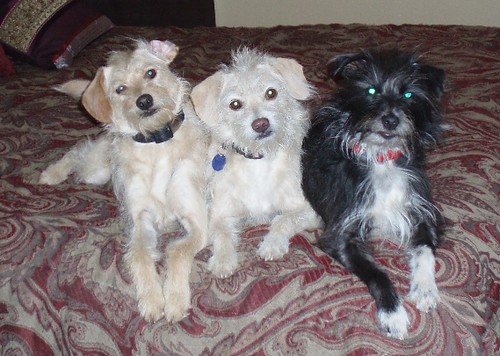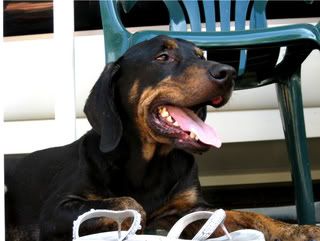As far as imprinting and what to do with a dog who has had no or very bad interaction during those crucial early weeks I think I can add a little knowledge to the subject.
Im currently working with a pup who had little to no human imprinting for the first 6 to 7 weeks of life.
For whatever the reasons may be he did "choose" me immediately upon seeing me and accepted my husband soon after. My son is non threatening and seen as another packmate, which is something we are still working on.
So we were lucky with that end of it, but it was a struggle to establish those boundaries of humans on top and dogs below without damaging the fragile bond he had with us.
We have been lucky with him as he took to clicker training like I have never seen before and adores working for me that way. It is a great bonding activity. I dont correct for obedience training at all at this point, only for pack structure issues and stuff like counter surfing.
He is still wary of strangers and people he doesnt see often but it is improving all the time and when dealing with behaviors, fears, or aggression that stem from prior living conditions only patience will solve them.
This goes against what most people here practice and think but
For us it helped as well that we had Loki, our 2 yr old hound mix that is the most tolerant loving easy going dog I have ever known, he made the transition easier on the pup I think because he was able to observe Loki's interactions with people and with us as well as having a gentle older pack mate with which to learn the routine and pack structure rules of a human house.
Even now with new people he is more likely to quickly approach them if he first sees Loki get excited and then recieve affection and see that nothing bad happened.
But huskies are extremely doggy most of the time as well as being highly pack oriented so this may differ depending on breed.
He is also a dominant personality, a high energy true working breed, fairly sharp, that combined with the fear issues could have easily produced an out of control dominant yet fearful aggressive dog. He is a handful for me that requires nearly constant work, In the hands of a novice or the wrong handler I can see how he could become a dangerous dog.
Setting the dog up for success is also highly important in my opinion, carefully controlling exposure to things that cause anxiety or aggression will facilitate you and the dog to gradually work through it.
I once took in 3 pups that were feral for all purposes. They were between 15-20 weeks at the time. It was weeks before they would come out of the kennel with me in the room. I literally spent hours each day sitting on the floor totally ignoring them and reading or even sleeping on a mat. It was nearly 3 months before I could easily pet or attempt to play with them.
at 6 months of working with them one of them was a fairly normal dog and able to go to a home.
The other two were just too sensitive so they stayed here together. The male was sweet and playful but would not wear a leash no matter how hard we tried, the female was a little more nervey and high strung. She would always look at us sideways out of the corner of eye and skitter away when we first came home. She learned to sit and down and that was it, the male was housetrained but would not work for us, he luckily had good manners though naturally.
Sadly the little female had to be put down due to brain damage stemming from a poison ingestion, she just became unpredictable and unsafe.
The male though now lives with a gentle older man who only wanted a companion but who also experienced with dogs. He still wont as much as sit on command and wont wear a leash without total freak out. But he makes a loving affectionate and enjoyable companion for someone who knows what he can truly expect from him.
 Previous Topic
Previous Topic Index
Index Next Topic
Next Topic











 Top
Top










